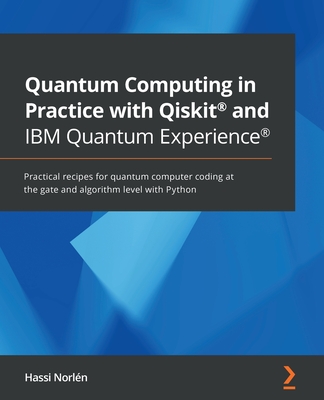Superconducting Qubit Design Using Qiskit Metal: Engineering of Superconducting Quantum Architecture
暫譯: 使用 Qiskit Metal 的超導量子比特設計:超導量子架構的工程學
Halder, Subhojit, A. Chauhan, Kinjal, Barfar, Muhamad Bagher
相關主題
商品描述
Understand and implement superconducting Qubit Design using Qiskit Metal in the Quantum Computing environment. This book provides practical knowledge and step-by-step guidance on designing, analyzing, and fabricating quantum chips.
The book begins with an introduction to the fundamentals of quantum computing, covering essential terms, concepts, and the history of quantum computers. It explores the differences between quantum and classical computers and provides an overview of superconducting qubits. Next, you will learn the theory and practical aspects of superconducting qubits. Detailed mathematical and computational analyses of different qubit types and circuits are provided, along with a comprehensive guide to creating quantum circuits using Qiskit and Qiskit Metal. You will learn to design quantum chips and analyze components such as Josephson junctions and qubit couplers, using advanced methods such as the Lumped Oscillator Model, Quasi-Lumped Oscillator Model, and Energy Participation Ratio Method. Finally, the book covers the fabrication of superconducting qubits, detailing the manufacturing process, requirements, and methods to address fabrication issues.
After reading this book, you will be able to advance your understanding and skills in this cutting-edge field, making complex concepts accessible and providing a roadmap for practical application.
What You Will Learn
- Install the Qiskit framework for creating basic quantum computing circuits
- Create your first superconducting qubit chip from scratch
- Formulate the back-end mathematical and computational model for the generated superconducting chips
- Understand the Quasi-LOM (lumped oscillator model) and how it differs from the LOM
Who This Book Is For
Quantum computing professionals working with superconducting qubits
商品描述(中文翻譯)
了解並實現使用 Qiskit Metal 在量子計算環境中設計超導量子比特。本書提供實用知識和逐步指導,幫助讀者設計、分析和製造量子晶片。
本書首先介紹量子計算的基本原理,涵蓋必要的術語、概念以及量子電腦的歷史。接著探討量子電腦與經典電腦之間的差異,並提供超導量子比特的概述。接下來,您將學習超導量子比特的理論和實際應用。書中詳細分析了不同類型的量子比特和電路的數學和計算分析,並提供使用 Qiskit 和 Qiskit Metal 創建量子電路的全面指南。您將學會設計量子晶片並分析如約瑟夫森接點(Josephson junctions)和量子比特耦合器(qubit couplers)等元件,使用先進的方法如集中振盪器模型(Lumped Oscillator Model)、準集中振盪器模型(Quasi-Lumped Oscillator Model)和能量參與比率方法(Energy Participation Ratio Method)。最後,本書涵蓋超導量子比特的製造,詳細說明製造過程、要求以及解決製造問題的方法。
閱讀完本書後,您將能夠提升在這一前沿領域的理解和技能,使複雜的概念變得易於理解,並提供實用應用的路線圖。
您將學到的內容:
- 安裝 Qiskit 框架以創建基本的量子計算電路
- 從零開始創建您的第一個超導量子比特晶片
- 為生成的超導晶片制定後端數學和計算模型
- 理解準集中振盪器模型(Quasi-LOM)及其與集中振盪器模型(LOM)的區別
本書適合對象:
從事超導量子比特的量子計算專業人士
作者簡介
Subhojit Halder is a graduate from India with a bachelor degree in Electronics and Telecommunication Engineering. He is a published author in quantum technologies and has several research articles in this field. His research focuses on astronomical simulations using quantum computing and integrating quantum technologies with existing classical systems. He has been awarded multiple patents and copyrights for his innovations, including a unique back-end kernel for Android devices that temporarily replicates quantum computations in cached memory, allowing for complex quantum circuit simulations with minimized noise errors.
Kinjal A. Chauhan is a researcher specializing in quantum technologies with a strong foundation in solid-state physics, computational physics, and quantum information. She holds a dual degree in Engineering Physics (BTech) and an MS in Solid State Physics from the Indian Institute of Space Science and Technology (IIST), Trivandrum. She has contributed to several cutting-edge research projects and published works in reputed journals such as Journal of Physics D: Applied Physics and Optical and Quantum Electronics, including studies on magnonic and photonics sensors. Currently a Junior Research Fellow at the Indian Institute of Technology, Delhi, she is focused on designing a quantum dot-based single-photon source and CNOT gate.
Muhamad Bagher Barfar is a researcher specializing in Quantum Technologies and SQUIDs (superconducting quantum interference devices), particularly with a background in Solid-State Physics (he has a BSc degree). He holds a double master degree in Optic-Laser and Theoretical Physics from Tarbiat Modares University, Tehran. He is also a QML researcher at Tarbiat Modares University in Iran and, a founding member of PlancQ group, working on Superconducting Quantum Chip Design.
Srinjoy Ganguly is a PhD researcher in quantum technologies at University College London focusing on heterogeneous neutral-atom-superconducting quantum architectures and an IBM Qiskit Advocate with more than seven years of experience in different aspects of quantum technologies (software and hardware). Formerly, he was a Lead Quantum AI Research Scientist at Fractal Quantum AI lab, a Clinical Professor of Practice for Quantum Technologies at Woxsen University, and an Associate Supervisor at the University of Southern Queensland supervising a PhD student in quantum machine learning. He is an author of multiple quantum books and research papers across quantum chemistry, quantum machine learning, quantum NLP, and materials science.
Shalini Devendrababu holds a master degree in Quantum Technologies from CSIC-UIMP, Spain. She is currently the lead Quantum AI Researcher at Fractal Quantum AI Lab. She authored a bestselling and highly rated Udemy course on Qiskit and has published research works on quantum material science with Springer and IEEE. She also wrote the world's first book exclusively dedicated to Product Managers in the field of quantum computing.She was featured in Times Square, New York Billboard as a part of mentoring and providing career guidance on Topmate in Quantum Computing. She is a seasoned speaker on quantum computing at various academic institutions as well as a writer on Medium.
作者簡介(中文翻譯)
Subhojit Halder 是來自印度的畢業生,擁有電子與電信工程的學士學位。他在量子技術領域發表過多篇研究文章,並且是該領域的出版作者。他的研究專注於利用量子計算進行天文模擬,並將量子技術與現有的經典系統整合。他因其創新而獲得多項專利和著作權,包括一種獨特的 Android 設備後端核心,該核心能夠在快取記憶體中暫時複製量子計算,從而實現複雜的量子電路模擬並最小化噪聲誤差。
Kinjal A. Chauhan 是一位專注於量子技術的研究人員,擁有堅實的固態物理、計算物理和量子信息的基礎。她擁有印度太空科學與技術學院(IIST)特里凡德倫的工程物理(BTech)雙學位和固態物理碩士學位。她參與了多個前沿研究項目,並在《Journal of Physics D: Applied Physics》和《Optical and Quantum Electronics》等知名期刊上發表過研究,包括對磁子和光子傳感器的研究。目前,她是德里印度理工學院的初級研究員,專注於設計基於量子點的單光子源和 CNOT 閘。
Muhamad Bagher Barfar 是一位專注於量子技術和 SQUID(超導量子干涉裝置)的研究人員,特別擁有固態物理的背景(他擁有理學士學位)。他擁有德黑蘭塔爾比亞特莫達雷斯大學的光學-激光和理論物理雙碩士學位。他也是伊朗塔爾比亞特莫達雷斯大學的 QML 研究員,並且是 PlancQ 團隊的創始成員,專注於超導量子晶片設計。
Srinjoy Ganguly 是倫敦大學學院的量子技術博士研究員,專注於異質中性原子-超導量子架構,並且是 IBM Qiskit 的倡導者,擁有超過七年的量子技術(軟體和硬體)各方面的經驗。之前,他曾擔任 Fractal Quantum AI 實驗室的首席量子 AI 研究科學家,並在 Woxsen 大學擔任量子技術的臨床實踐教授,以及在南昆士蘭大學擔任副導師,指導一名量子機器學習的博士生。他是多本量子書籍和研究論文的作者,涵蓋量子化學、量子機器學習、量子自然語言處理和材料科學等領域。
Shalini Devendrababu 擁有西班牙 CSIC-UIMP 的量子技術碩士學位。她目前是 Fractal Quantum AI 實驗室的首席量子 AI 研究員。她撰寫了一門在 Udemy 上熱賣且評價極高的 Qiskit 課程,並在 Springer 和 IEEE 上發表了量子材料科學的研究作品。她還撰寫了全球首本專門針對量子計算領域產品經理的書籍。她曾在紐約時代廣場的廣告牌上亮相,作為 Topmate 在量子計算領域提供職業指導的導師。她是多所學術機構的量子計算演講者,也是 Medium 的作家。



















